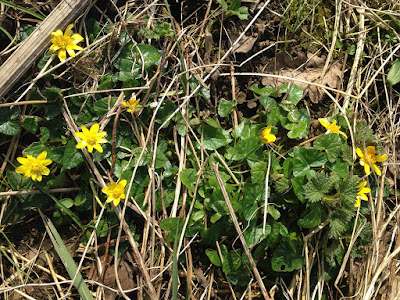We had a fabulous day out at
Malham Cove in North Yorkshire on Sunday 19th June.
We met at the Yorkshire Dales National Park car park in Malham village, and Les gave us a quick talk on the
Peregrine Falcons we were hoping to see up at Malham Cove. The walk to the Cove took us along the stream through the village.
Swallows were coming down to a little "beach" by the stream, bringing dry grass in their beaks. The birds then scooped up some mud from the shore and flew off to build or repair their nests (presumably in a nearby barn).
The Swallow flew down with a short piece of grass in its beak...
...then scooped up a mouthful of mud before flying off.
Further on,
House Sparrows were bathing in the stream by the village shop. On the other side of the village we headed through a small deciduous wood, which was full of birdsong. We could hear
Chiffchaffs,
Blackbirds,
Jackdaws, and
Chaffinches, with
House Martins overhead. We spotted a family of
Wrens on the dry-stone wall by the stream. The family probably nested in a cavity in the wall - the Wren's scientific name is
Troglodytes, which means "cave-dweller".
Young Wren, Malham, North Yorkshire - Sunday 19th June 2016
The walk to the Cove is lovely, and the view is very impressive.
Malham Cove, North Yorkshire - Sunday 19th June 2016
A young
Wheatear was among the rocks beside the path and was being attended to by its parents. Our visited clearly coincided with many young birds leaving their nests.
Wheatear, Malham, North Yorkshire - Sunday 19th June 2016
The
RSPB Peregrine Monitoring Team were waiting at the Cove, where they keep a round-the-clock watch on the nesting Peregrines. They immediately pointed out the adult male
Peregrine perched in an Ash tree high up on the side of the Cove!
Peregrine Falcon, Malham, North Yorkshire - Sunday 19th June 2016
The RSPB team gave us a really interesting talk about the Peregrines and answered our many questions. We were shown two stick models of the male and female Peregrine, to help us appreciate their size, and to see just how much bigger the female is compared to the male.
Most of the kids were off watching Peregrines or searching for moles or fungi!
We heard how the Peregrine suffered terribly in the past from illegal killing by humans and from widespread contamination by persistent toxic agricultural chemicals such
as DDT. After the banning of DDT in the 1980s, the Peregrine population has recovered brilliantly to about 1400 pairs (in 2002 - probably more now), from a low of only 360 in the 1960s. Unfortunately Peregrines are still persecuted - they have few fans in the Grouse-shooting industry or among Pigeon fanciers.
The Peregrine had caught a small bird, possibly a Blackbird. He flew
around the Cove carrying the prey, while calling to the young
Peregrines. He then settled back on the Ash tree and continued to eat
the prey.
Peregrine Falcon, Malham, North Yorkshire - Sunday 19th June 2016
By the feeders near the Peregrine watch point, we could see another striking bird: the
Redstart. These birds spend the winter in north Africa and migrate north in Spring to breed in this type of grassy, wooded upland area. A beautiful male Redstart kept watch over its fledgling in the grass.
Redstart, Malham, North Yorkshire - Sunday 19th June 2016
And searching for insects around the cattle was this lovely
Pied Wagtail.
Pied Wagtail, Malham, North Yorkshire - Sunday 19th June 2016
Thank you to everyone who joined us for this fascinating trip.

















































